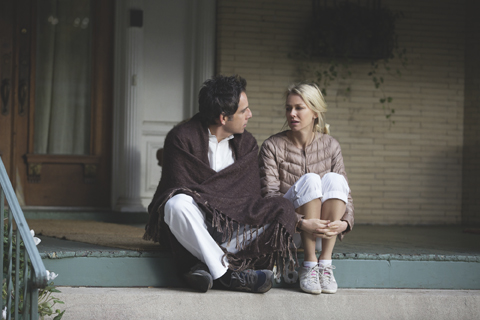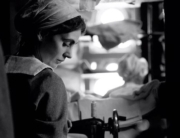
Gemma Arterton being fed by Ryan Reynolds in The Voices (All photos: Toronto International Film Festival)
After more than a week seeing 41 movies (in addition to the 21 seen earlier), I found few obvious outstanding discoveries at the Toronto International Film Festival compared with last year, whose standouts included the beautifully made Ida, the raucous We Are the Best!, and a stronger sampling of art films. Overall, the best selections this year already debuted months ago at Cannes: the hall of mirrors chamber piece Clouds of Sils Maria, the shocker The Tribe, and Marion Cotillard’s best work yet, Two Days, One Night. In addition, there was the Russian drama Leviathan; A Hard Day, the deliriously exuberant cop thriller from South Korea; and from the United States, Whiplash, an invigorating two-hander. Look for these films during the fall festivals. (Whiplash opens on October 10th.)
Some festivals tend to give out a deluge of awards. (Tribeca even hands out prizes for editing.) However, the honor bounty in Toronto is limited to a mere 10, yet the smallest recognition might help any of the 285 selected feature films to stand out from the pack. The People’s Choice Award, which gets the most media attention as an Oscar predictor, went to the British biopic The Imitation Game, about coding prodigy Alan Turing and his solving of the Nazi’s secret Enigma code. It’s a work that wouldn’t be out of place on PBS’s Masterpiece. Actually, a multipart miniseries would have been more appropriate. There is so much on this film’s plate that it overflows: Turing’s prosecution for gross indecency could have been a movie in and of itself.
The International Critics’ Prize (the FIPRESCI Prize) gave its honor for best film to Oren Moverman’s Time Out of Mind, starring Richard Gere (one of the film’s producers) as a homeless man in New York. It’s a film that thrives or stalls, depending on your acceptance of Gere in this atypical role.
Nevertheless, there were still memorable movies to be found, two in particular confirming their stars’ status. After taking the lead in too many lukewarm Hollywood films, Ryan Reynolds finally flourishes in a twisted turn in The Voices. His comic chops on full display, he chews the well-designed, color-coordinated scenery. And Kristen Wiig takes on another bold role, after Loveship Hateship, in the satire Welcome to Me, Shira Piven’s splashy debut.
The production designs of director Marjane Satrapi (Persepolis) are as visually eye-popping, imaginative, and seductive as those of Terry Gilliam and Tim Burton and accompany a much stronger and focused narrative. If her new film, The Voices, comes across as artificial, it’s intentional. Although it’s not particularly deep, viewers will find it hard to resist the candy colored, overly bright perspective of small-town factory worker Jerry (Reynolds), partly because the alternative would be disgusting and grotesque. He has violent tendencies, to put it mildly, and once he takes his court-ordered medication, he views the drab world for what it is.
Without the drugs, Jerry sees his life in vivid Technicolor and the voices in his head take control. Actually, it’s his dog and cat who offer counsel: the comforting hound dog Bosco, in a Southern drawl, and nefarious feline Mr. Whiskers, who appeals to Jerry’s darker side. (Reynolds provides the vocal ammunition for both pets.) This is probably the most R-rated talking animal movie ever: Mr. Whiskers, an orange tabby, goads Jerry on, telling him that one is only true alive when killing, in between spewing out obscenities in a thick Scottish brogue. He warns Jerry that taking his medication means entering a bleak, lonely world.
Reynolds bring a James Stewart, “Ah, shucks” charm to the role, as well as a stiff awkwardness when Jerry’s near the beautiful company accountant Fiona (Gemma Arterton, who also shines in the festival’s Gemma Bovery). From the moment Reynolds first appears, the audience will immediately accept the movie star as a timid loner.
Satrapi takes a big risk in possibly turning off her Persepolis and Chicken with Plums fan base by not downplaying the grisly mayhem unleashed upon the women in Jerry’s very small social circle. However, the energetic performances and abrupt shifts in tone make it difficult for viewers to remain indifferent to the blend of the macabre, cockeyed optimism, and blood splattering. Ending the film on a high note, Satrapi leaves the audience wanting more with a grand finale, a closing credits sequence that’s over the top in its cheekiness.
Similarly, in Welcome to Me, Kristen Wiig delivers an unhinged, deliriously deadpan performance of an emotionally stunted loner who is also off medication. Alice Krieg lives near the freeway in a Palm Desert, California, hotel with her TV always on, surrounded by stacks of videotapes of Oprah Winfrey’s talk show. She’s living in a time warp: rather than a cell phone, she has a bulky answering machine. Alice can recite her medical condition like a shopping list: manic depression at 16, now borderline personality disorder. She can also add being an affirmation addict to her list of issues, having learned Oprahese by rote.
When Alice strikes it rich, collecting a $85,000,000 lottery prize, she calmly credits her windfall with her belief that she has always been a winner. Now a professed “member of the rich and famous,” she moves into a suite at a nearby casino and writes a check for $15,000,000 to a financially struggling consumer cable channel, which then gives her free rein to host her own weekly show. When the befuddled network brass ask what her program, Welcome to Me, will be about, Alice replies, “Me, who I think is a cunt, and spirituality…. Like Oprah with a swan boat.” With the lowest of production values, her show features reenactments of her life and offers the segment “Smelling Things Before They Happen.”
When it was first released nearly 40 years ago, Sidney Lumet’s Network seemed far-fetched, with its prediction of sensational, reality-based television. But the advent of TV shows such as Extreme Makeover and the recent Born in the Wild have come to emphasize how ahead of its time that film really was. Welcome to Me, on the other hand, is about the here and now of “emotional exhibitionism,” as Alice’s mother calls it.
It’s amazing that the filmmakers were granted the right to use footage from Oprah as well as the magazine covers of O, Alice’s bible. Winfrey is never the object of ridicule; it’s Alice’s generalized, self-involved epiphanies that take a bruising. Some of the targets fall flat (I could have done without a bit about Alice’s humanitarian efforts to save the male dog population), but more often than not, its observations are pungent. It has been two years since Wiig left Saturday Night Live, and she has ventured into fascinating and noncommercial fare. She has one of the balliest acting careers out there.
Ethan Hawke is another actor having a very good year. He gave one of his best performances in Boyhood, he made and brought to the festival his affectionate tribute to a New York piano teacher in Seymour: An Introduction, and he’s the nuts and bolts holding together Good Kill, a different sort of war film for a new type of high-tech warfare.
Seven thousand miles away from Afghanistan, Maj. Tom Egan lives and works in Las Vegas, a surreal setting into its self. Out in the desert, he works in what looks like a cargo container with a sign on the door announcing, “You are now leaving the U.S.” Inside he sits in front of a control panel with dozens of monitors taken from an unmanned aircraft flying over Taliban-infiltrated territory. With what looks like the joystick of a video game, he presses a button, dropping an explosive and obliterating what’s been designated as a bomb-making factory.
Egan lives with his wife and kids and works the day shift: he has the good life, as he’s informed by his commanding officer who quashes the major’s request to return to combat. A pilot without a plane, he misses the rush; now the only bodily harm he encounters is carpal tunnel syndrome.
The audience, like Egan, is a voyeur. Placing viewers in Egan’s power seat imbues the film with a charge and a steadily building intensity. The numerous, varied scenes of Egan and his team figuring out who on the monitors is a terrorist and the questioning of their mission are the most provocative and successful parts of the drama, especially when the CIA takes charge, choosing targets based on patterns of behavior, not confirmed evidence.
However, scenes of Egan’s home life are obvious and predictable. Egan drinks and remains closed off, and wife Molly (January Jones as the resentful and decreasingly patient wife) pouts. She knows Tom stores booze in the bathroom, and he won’t open up. Even when pushing Egan’s buttons, Molly doesn’t quite let loose in the marital spats.
Hawke, on the other hand, maintains a quiet anger in a very internalized performance that’s subtle where the film is not. Director Andrew Niccol hammers home Egan’s alcoholism by cutting to frequent shots of vodka bottles lying on the floor of Egan’s car, and the script often spells out too clearly the moral dilemmas in sound bites. To the film’s credit, though, it deliberately and directly questions U.S. military tactics and keeps the viewer questioning Egan’s actions until the very end.
Set far from the scene of battle, Good Kill is nowhere as intense as The Hurt Locker or as visceral as Lone Survivor and so may have a harder time getting noticed. Unlike so many movies based on real events, this one arrives on time, not a few years too late. Unfortunately, this well-deserving film didn’t make Criticwire’s top 50 TIFF list: a sign of the glut of films at the festival.
And now for the disappointments. When one thinks of the Amanda Knox murder trial, issues of nationalism, anti-Americanism, questionable police conduct, or the peculiarities of the Italian legal system may come to mind. In Michael Winterbottom’s barely veiled version of the tabloid-headlining case, The Face of an Angel, he defuses the material, in what feels more like a rough draft than a final cut. The dialogue is pedestrian, the structure slapdash, and what passes as a twist is barely an afterthought.
Winterbottom moves the focus away from Knox’s stand-in, here named Jessica Fuller, and instead concentrates on a British filmmaker grappling with the challenge of telling the story of the fatal stabbing of a British student studying abroad. Though he has been handpicked by the producers, the onscreen director, Thomas (sullenly played by Daniel Bühl), has no idea how to approach the subject, except, oddly, to base it on Dante’s Inferno, and to turn the slain student, here named Elizabeth Price, into a contemporary Beatrice.
There’s no reason for viewers to care about Thomas, no matter how many times the filmmakers attempt to wring pathos by showing him at his computer watching a video of his nine-year-old daughter. He spends more time conducting amateurish research and snorting coke than delving into Jessica’s guilt or innocence.
Kate Beckinsale has little to do as Thomas’s Rome-based guide, Simone. Her journalist and Brühl’s navel-gazing director have one of the most desultory affairs in recent film. What shakes off the lethargy, though, is the vivacious debut of model Claire Delevingne as a British student/party girl, Thomas’s entry into the not-so-scary underworld of foggy Siena (in lieu of Perugia). At least the scenery has character. In a gesture of grandiosity, the director has dedicated the film to Meredith Kercher, the actual murder victim.
After his light-footed Frances Ha, which had verve to spare, director Noam Baumbach takes a decaffinated and sitcomish approach to a boulevard comedy of early middle-age behavior in While We’re Young. Ben Stiller stars as regular guy Josh, a documentary filmmaker whose early work can only be found on eBay. For 10 years, he has been working on his latest project, yet he lives in a spacious Brooklyn home with wife, Cornelia (Naomi Watts), who produces the works of her father, a documentary heavyweight. (In the movie, dad’s given a tribute at the New York Film Festival in a sequence filmed at last year’s event. How awkward it must have been for the NYFF to, apparently, turn down this movie after showcasing many of Baumbach’s earlier films.)
Josh and Cornelia have been drifting apart from their best friends, who “Ooh” and “Aah” over their newborn and who, like recent and overzealous converts, try to push parenthood on the couple. Josh and Cornelia have made several unsuccessful attempts at having children, and she doesn’t want to try again. He’s 44, and she’s 43. And since they’re free, they can always hop on a plane to Paris for the weekend. (Good work if you can get it.) They take up with a young married duo instead: Darby (Amanda Seyfried, itching to do more), who makes ice cream, and aspiring filmmaker Jamie (Adam Driver). Ben is energized hanging out with them, but Cornelia thinks Jamie overly studies her husband and wonders if the younger man may have ulterior motives.
The premise strains to carve out a generation gap, when there really isn’t one, at least culturally. All four know the same music and eat at the same restaurants. It’s really a matter of drive and ambition that separates them. Many of the running gags (in one sequence, the gagging is literal) aren’t funny even at the first go-round, including Cornelia’s attempts at hip-hop dance. The older couple’s arguing on a street corner is repetitive and phoned-in—no wonder the passersby don’t take notice.
However, Adam Driver throws off his slacker aloofness in Italian director Saverio Costanzo’s (Private) first English language venture. Driver was one of several actors with at least three films at the festival (This Is Where I Leave You makes a trio). Brady Corbet and Chloë Grace Moretz also popped up everywhere. Costanzo’s divisive Hungry Hearts lingers days after other movies fade to the background. It has somber shades of a 1970s giallo cross-bred with a no-budget, grungy New York indie and a certain Roman Polanski film. When the camerawork becomes noticeably handheld, trouble is on the way.
Gangly New Yorker Jude (Driver) and Italian translator Mina (the birdlike Alba Rohrwacher) meet not so cute in in a locked, odorous bathroom at a Chinese restaurant. Fast forward through randy bedroom scenes, marriage, and a pregnancy that has left Mina dangerously underweight, despite her doctor’s admonition to eat more vegetables and protein.
Seven months later after his birth, their baby isn’t growing and has had a fever for two weeks. Though Mina forbids antibiotics, formula, and dairy, claiming she has done all her research, Jude adheres to this bizarre, self-curated health regime for their son. Mina’s goal: to keep her baby “pure.” (Ah, why are they still living in Manhattan?) She hasn’t let the infant out inside at all. Conveniently, she has private, rooftop access to her own garden, shielded from the polluted air by plastic warp. When Jude finally drops his calm façade and lashes out, Mina plays her one card: “You should trust me. I’m his mother.” And if that doesn’t work: “Don’t forget we’re a family.”
Jude, after much negotiation, takes his son to the doctor. The diagnosis: malnourishment. Even after Jude insists on giving the boy a diet apart from the vegan one imposed by his wife, the baby still fails to gain an ounce. (Followers of the holistic food movement will squirm.)
This is not a passive viewing experience; viewers might be exasperated by Mina’s behavior, but they’ll never be bored. The film becomes claustrophobic as it goes along, with Costanzo, also the film’s camera operator, getting directly into the actors’ faces with a warping fish lens.
The Venice Film Festival over-generously gave the genre-bending film two major awards, for best actor and actress. The soulful Rohrwacher channels an anemic sleepwalker by the end. Driver, by contrast, is incredibly calm, patient, and loving, even during the worst circumstances, and it’s Jude’s refusal to see Mina as a monster that keeps her from becoming the most hated woman since Glenn Close killed the pretty rabbit. This remains true when a Psycho-like stab of strings announce the arrival of Mina on screen. Driver takes the black-and-white premise and gives it grainy color.









Leave A Comment